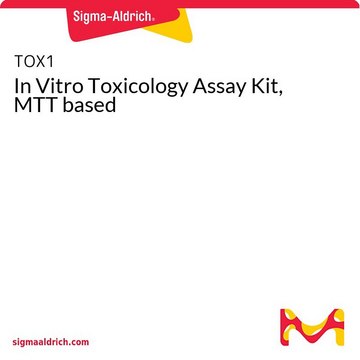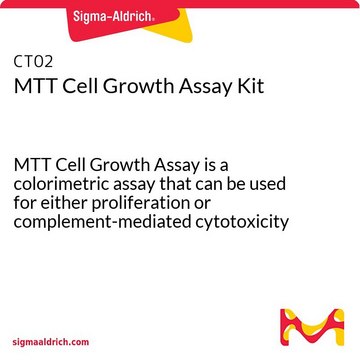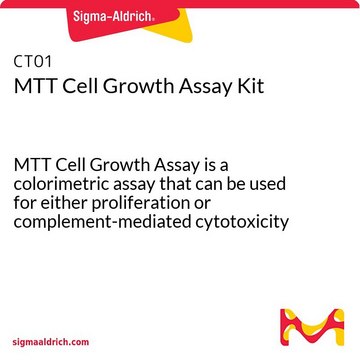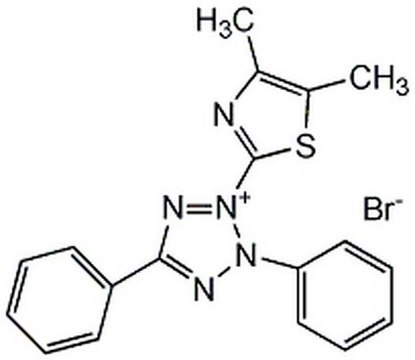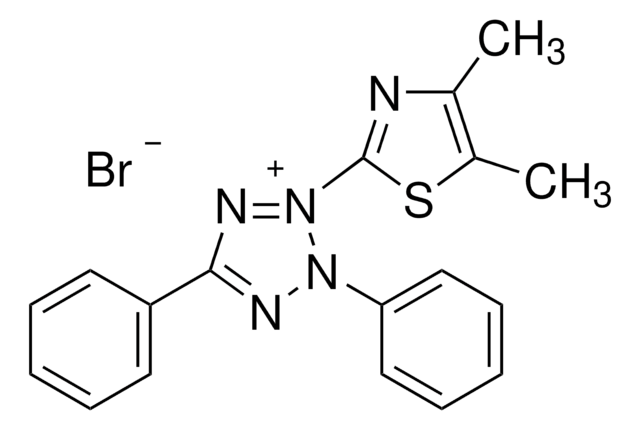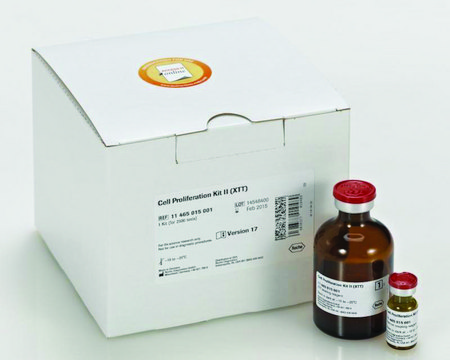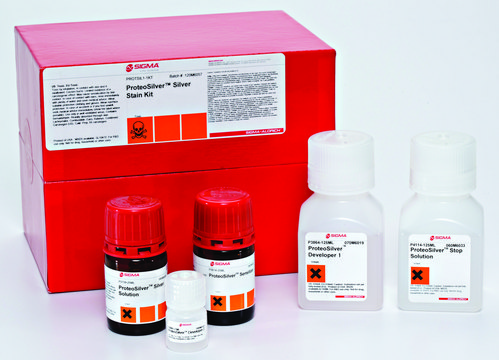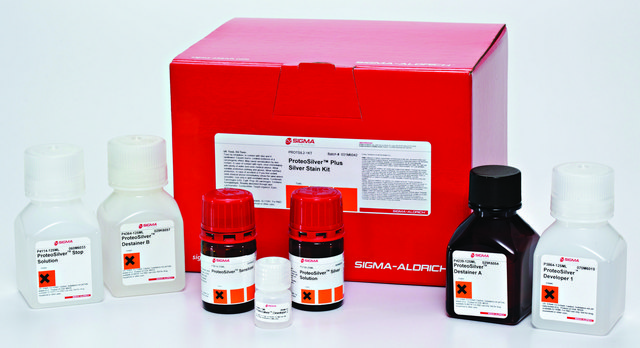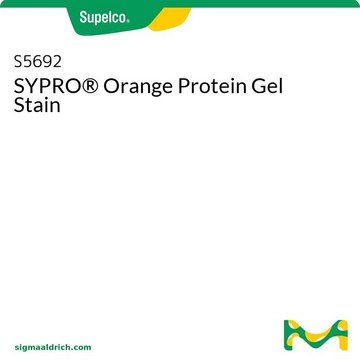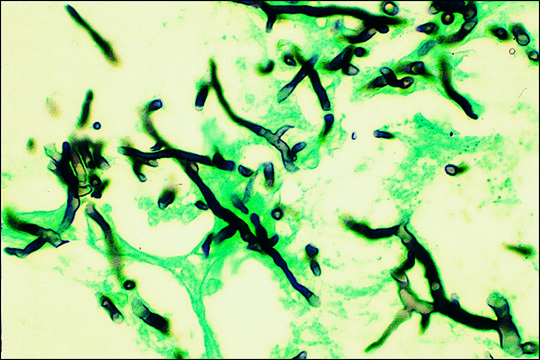CGD1
Cell Growth Determination Kit, MTT based
Synonym(s):
Mitochondrial activity assay
Select a Size
¥3,135.99
Estimated to ship on2025年4月07日Details
Select a Size
About This Item
¥3,135.99
Estimated to ship on2025年4月07日Details
Recommended Products
packaging
pkg of 1 kit
technique(s)
UV/Vis spectroscopy: suitable
protein quantification: suitable
Amax
570 nm
application(s)
cell analysis
detection
detection method
colorimetric
shipped in
dry ice
storage temp.
−20°C
1 of 4
This Item | PROTSIL2 | S5692 | HT100A |
|---|---|---|---|
| usage kit sufficient for 25 mini-gels (10 × 10 cm) | usage kit sufficient for 25 mini-gels (10 × 10 cm) | usage - | usage - |
| Quality Level 200 | Quality Level 200 | Quality Level 200 | Quality Level 500 |
General description
Application
- to measure the cell viability of preosteoblastic cells[1]
- in MTT (3-(4, 5-dimethylthiazolyl-2)-2, 5-diphenyltetrazolium bromide) assay of normal human prostatic stromal and epithelial cell lines[2]
- to determine the cell viability of primary cervical epithelial cells[3]
Packaging
related product
Signal Word
Danger
Hazard Statements
Precautionary Statements
Hazard Classifications
Eye Irrit. 2 - Flam. Liq. 2 - Muta. 2 - STOT SE 3
Target Organs
Central nervous system
Storage Class Code
3 - Flammable liquids
Flash Point(F)
53.6 °F - closed cup
Flash Point(C)
12 °C - closed cup
Regulatory Information
Choose from one of the most recent versions:
Already Own This Product?
Find documentation for the products that you have recently purchased in the Document Library.
Which document(s) contains shelf-life or expiration date information for a given product?
If available for a given product, the recommended re-test date or the expiration date can be found on the Certificate of Analysis.
How do I get lot-specific information or a Certificate of Analysis?
The lot specific COA document can be found by entering the lot number above under the "Documents" section.
Can we use media with phenol red with Product CGD1, Cell Growth Determination Kit?
You most likely would not be able to use a medium containing phenol red with this kit. We have found that the phenol red can contribute to higher background, and therefore lower sensitivity.
What is the difference between Product No. CGD1, Cell Growth Determination Kit and Product No.TOX1, In Vitro Toxicology Assay Kit?
Product No. CGD1 and TOX1 are both MTT based assays. The major difference between Product No. CGD1 and TOX1 is that TOX1 contains 10 % Triton X-100 in the solubilization solution for better lysis of the cells and solubilization of the MTT. If there is complete cell lysis, the results obtained with both kits would be the same. The MTT in this kit is a solution, whereas the TOX1 assay kit contains the MTT as a powder that is solubilized before use.
What are the components of the Product No. CGD1, Cell Growth Determination Kit and Product No.TOX1, In Vitro Toxicology Assay Kit?
CGD1 contains 5 vials of 5 mg/vial of MTT and 50 ml of MTT solvent (solubilization solution) and TOX1 contains 5 vials of 15 mg/vial of MTT and 125 ml of solubilization solution.
Is 10% fetal bovine serum (FBS) in the culture medium compatible with Product CGD1, Cell Growth Determination Kit?
High protein levels may form a precipitate when the MTT solubilization solution is added. Samples with protein concentrations equivalent to 10% FBS or 4 mg/mL protein seem acceptable.
How do I find price and availability?
There are several ways to find pricing and availability for our products. Once you log onto our website, you will find the price and availability displayed on the product detail page. You can contact any of our Customer Sales and Service offices to receive a quote. USA customers: 1-800-325-3010 or view local office numbers.
What is the Department of Transportation shipping information for this product?
Transportation information can be found in Section 14 of the product's (M)SDS.To access the shipping information for this material, use the link on the product detail page for the product.
Is the MTT assay quantitative?
The MTT asay is a method to assess cell viability. This assay is a semiquantitative assay. The assay is used to compare the viability changes in treated cells to untreated cells. The absorbance is indicative of the cell number. The higher the absorbance, the greater the number of viable cells present. Most researchers compare the absorbance of the two samples as a ratio (ABS treated cells/ABS untreated cells) to get a fold increase/decrease in cell number.
What is the difference between product CGD1, Cell Growth Determination Kit and product TOX1, In Vitro Toxicology Assay Kit?
Product CGD1 and TOX1 are both MTT based assays. The major difference between product CGD1 and TOX1 is that TOX1 contains 10 % Triton X-100 in the solubilization solution for better lysis of the cells and solubilization of the MTT. If there is complete cell lysis, the results obtained with both kits would be the same. The MTT in this kit is a solution, whereas the TOX1 assay kit contains the MTT as a powder that is solubilized before use.
My question is not addressed here, how can I contact Technical Service for assistance?
Ask a Scientist here.
Articles
Quality control guidelines to maintain high quality authenticated and contamination-free cell cultures. Free ECACC handbook download.
Our team of scientists has experience in all areas of research including Life Science, Material Science, Chemical Synthesis, Chromatography, Analytical and many others.
Contact Technical Service
